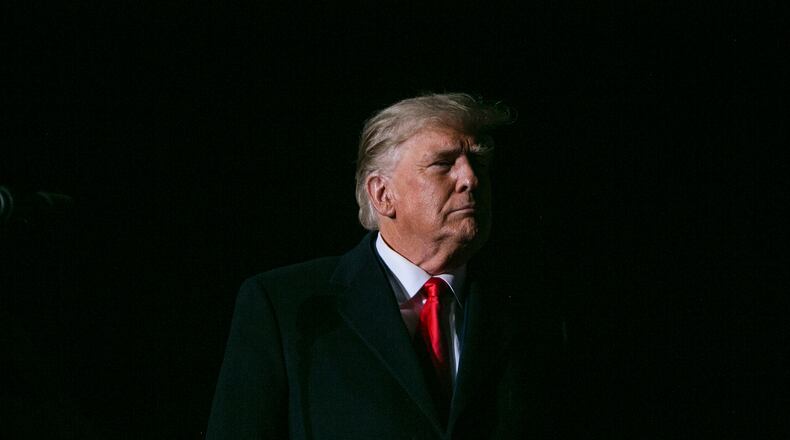The investigation by the Manhattan district attorney’s office into Donald Trump’s hush-money payments to a porn star, which led to the vote to indict the former president, has spanned nearly five years.
Here are some key moments:
Aug. 21, 2018
Michael Cohen says he arranged hush-money payments for the president, and the investigation begins.
Cohen, previously a personal lawyer and fixer for Trump, pleaded guilty to federal crimes and told a court that Trump had directed him to arrange hush-money payments to two women. The payments were made during the 2016 campaign to keep the women from speaking publicly about affairs they said they had conducted with Trump.
Soon after Cohen’s admission, the Manhattan district attorney’s office opened an investigation to examine if the payments broke New York state laws. The office soon paused the inquiry at the request of federal prosecutors, who were still looking into the same conduct.
August 2019
The district attorney’s office subpoenas the Trump Organization.
After federal prosecutors said they had “effectively concluded” their investigation, Cyrus Vance Jr., the Manhattan district attorney at the time, revived his own inquiry. Late in the month, prosecutors in his office issued a subpoena to the Trump Organization and another subpoena to Trump’s accounting firm, demanding eight years of Trump’s personal and corporate tax returns.
Sept. 19, 2019
Trump’s lawyers sue to protect his tax returns.
The lawsuit, filed in U.S. District Court in Manhattan, argued that a sitting president cannot be criminally investigated. It led to a lengthy delay.
July 9, 2020
Vance wins his first key victory at the U.S. Supreme Court.
After appellate judges ruled against Trump, the lawsuit found its way to the Supreme Court, where the justices ruled that the presidency did not shield Trump from criminal inquiries and that he had no absolute right to block the release of his tax returns.
The ruling left Trump with the opportunity to raise different objections to Vance’s subpoena.
Fall of 2020
The investigation intensifies.
Prosecutors interviewed employees of the main bank and insurance company that serve Trump and issued several new subpoenas.
The district attorney’s office also signaled in another court filing that it had grounds to investigate the president for tax fraud.
Feb. 22, 2021
The Supreme Court denies Trump’s final bid to block the release of his returns.
The brief unsigned order was a decisive defeat for Trump and a turning point in Vance’s investigation.
Just hours later, eight years of financial records were handed over to Vance’s office.
March 1, 2021
The investigation’s focus turns to a top executive.
In the spring, Vance’s prosecutors set their sights on Allen Weisselberg, the Trump Organization’s long-serving chief financial officer, whom they hoped to pressure into cooperating with their investigation.
The prosecutors were particularly interested in whether the Trump Organization handed out valuable benefits to Weisselberg as a form of untaxed compensation.
July 1, 2021
The Trump Organization is charged with running a 15-year tax scheme.
When Weisselberg refused to testify against his boss, prosecutors announced charges against him and Trump’s company, saying that the company helped its executives evade taxes by compensating them with benefits such as free cars and apartments that were hidden from the authorities.
Jan. 1, 2022
A new Manhattan district attorney takes office.
Vance left office, and his successor, Alvin Bragg, took over the case. Both are Democrats.
Bragg, a former federal prosecutor, retained two of the investigation’s leaders, Mark Pomerantz, an experienced former federal prosecutor and white-collar defense lawyer, and Carey Dunne, Vance’s general counsel.
Feb. 23, 2022
Two prosecutors resign, leaving the investigation’s future in doubt.
After Bragg expressed reservations about the case, Pomerantz and Dunne suspended the presentation of evidence about Trump to a grand jury. A month later, they resigned, prompting a public uproar over Bragg’s decision not to proceed with an indictment.
In his resignation letter, which was later obtained by The New York Times, Pomerantz said Trump had been guilty of numerous felonies.
Aug. 18
Bragg’s investigation continues.
After staying mostly silent through weeks of criticism, the district attorney publicly discussed his office’s investigation of Trump for the first time. His fundamental message: The inquiry would continue.
Aug. 18
Weisselberg pleads guilty and agrees to testify against the Trump Organization.
Although the chief financial officer declined to turn on Trump himself, he agreed to testify at the October trial against the company that he had served for nearly a half-century.
Late summer
The prosecutors turn back to hush money.
After several months, Bragg’s prosecutors returned to the long-running investigation’s original focus: a hush-money payment to Stormy Daniels, the porn star, who said she had a sexual relationship with Trump.
Dec. 24
The Trump Organization is convicted, securing a significant victory for the district attorney.
Bragg’s prosecutors won a conviction of Trump’s family business, convincing a jury that the company was guilty of tax fraud and other crimes.
January
The district attorney impanels a new grand jury.
The grand jury met throughout the next three months and heard testimony about the hush-money payment from at least nine witnesses.
Midwinter
Prosecutors signal that an indictment is likely, offering Trump a chance to testify before the grand jury.
Such offers almost always indicate an indictment is close; it would be unusual to notify a potential defendant without ultimately seeking charges against him.
March 18
Trump predicts his arrest and calls for protests.
Without any direct knowledge, the former president posted on his Truth Social account that he would be arrested three days later and sought to rally supporters to his side. His prediction was soon walked back, and he was not arrested at that time.
Thursday
Grand jury votes to indict Trump.
The charges, which are still unknown, will be the first against any U.S. president.
This article originally appeared in The New York Times.
Keep Reading
The Latest
Featured

